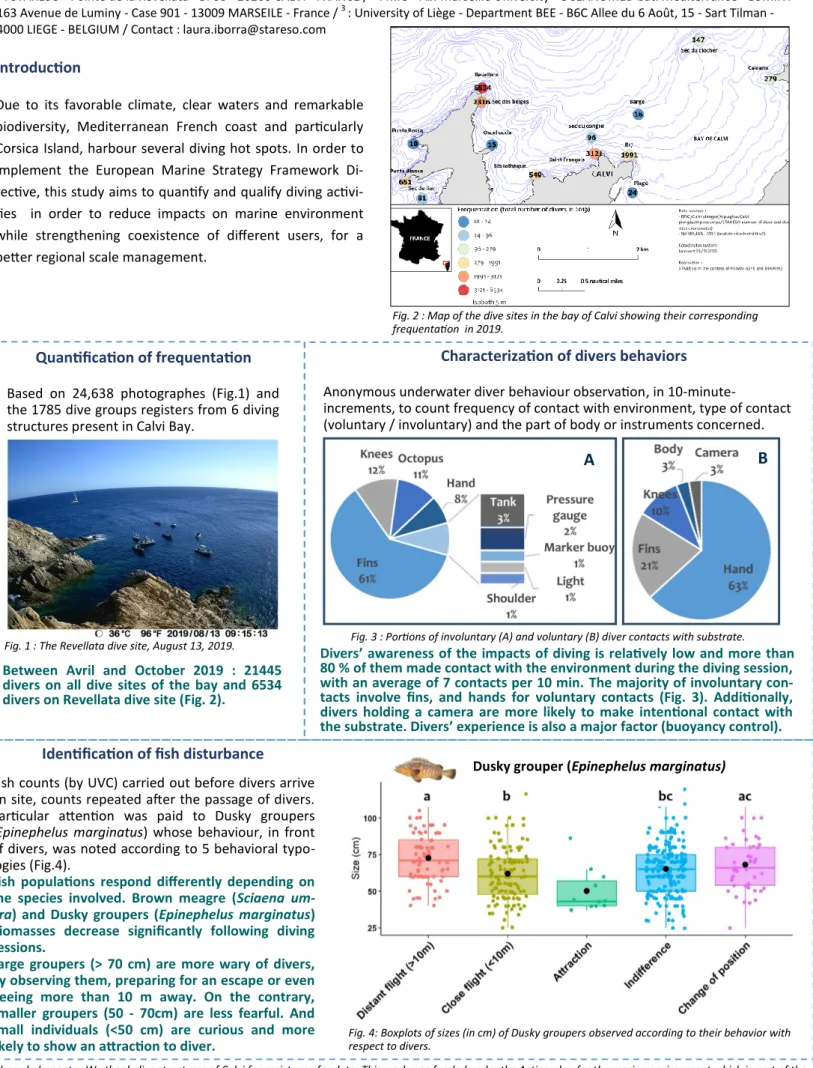Diving Impact: Frequentation, Diver Behavior and Consequences on the
Mediterranenan Fish Community
Laura IBORRA1, Michèle LEDUC1, Philippe CUNY2, Sylvie GOBERT1,3 1
: STARESO - Pointe de la Revellata - BP33 - 20260 CALVI - FRANCE / 2 : MIO - Aix-Marseille University - OCEANOMED bât. Méditerranée - LUMINY - 163 Avenue de Luminy - Case 901 - 13009 MARSEILE - France / 3 : University of Liège - Department BEE - B6C Allee du 6 Août, 15 - Sart Tilman - 4000 LIEGE - BELGIUM / Contact : laura.iborra@stareso.com
Introduction
Due to its favorable climate, clear waters and remarkable biodiversity, Mediterranean French coast and particularly Corsica Island, harbour several diving hot spots. In order to implement the European Marine Strategy Framework Di-rective, this study aims to quantify and qualify diving activi-ties in order to reduce impacts on marine environment while strengthening coexistence of different users, for a better regional scale management.
Between Avril and October 2019 : 21445 divers on all dive sites of the bay and 6534 divers on Revellata dive site (Fig. 2).
Quantification of frequentation
Based on 24,638 photographes (Fig.1) and the 1785 dive groups registers from 6 diving structures present in Calvi Bay.
Fig. 1 : The Revellata dive site, August 13, 2019.
Fig. 2 : Map of the dive sites in the bay of Calvi showing their corresponding frequentation in 2019.
Characterization of divers behaviors
Anonymous underwater diver behaviour observation, in
10-minute-increments, to count frequency of contact with environment, type of contact (voluntary / involuntary) and the part of body or instruments concerned.
Divers’ awareness of the impacts of diving is relatively low and more than 80 % of them made contact with the environment during the diving session, with an average of 7 contacts per 10 min. The majority of involuntary con-tacts involve fins, and hands for voluntary concon-tacts (Fig. 3). Additionally, divers holding a camera are more likely to make intentional contact with the substrate. Divers’ experience is also a major factor (buoyancy control).
A
B
Fig. 3 : Portions of involuntary (A) and voluntary (B) diver contacts with substrate.
Identification of fish disturbance
Fish counts (by UVC) carried out before divers arrive on site, counts repeated after the passage of divers. Particular attention was paid to Dusky groupers (Epinephelus marginatus) whose behaviour, in front of divers, was noted according to 5 behavioral typo-logies (Fig.4).
Fish populations respond differently depending on the species involved. Brown meagre (Sciaena um-bra) and Dusky groupers (Epinephelus marginatus) biomasses decrease significantly following diving sessions.
Large groupers (> 70 cm) are more wary of divers, by observing them, preparing for an escape or even fleeing more than 10 m away. On the contrary, smaller groupers (50 - 70cm) are less fearful. And small individuals (<50 cm) are curious and more likely to show an attraction to diver.
Dusky grouper (Epinephelus marginatus)
Fig. 4: Boxplots of sizes (in cm) of Dusky groupers observed according to their behavior with respect to divers.
Acknowledgments : We thank dive structures of Calvi for assistance for data. This work was funded under the Action plan for the marine environment which is part of the European Marine Strategy Framework Directive.
